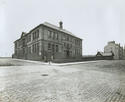 Until about 1870 Possilpark was nothing much more than a mansion house and home farm with few residents. The gates of the house were at what is now Saracen Cross and its last resident was Sheriff Alison in the middle years of the 19th century. Following his death in 1867, the property was acquired by Walter Macfarlane who, attracted by the newly built railway, moved his celebrated architectural ironworks there from Anderston. Other industrial concerns soon followed suit and by the outbreak of the First World War Possilpark was an industrial district, which had become part of Glasgow in 1891.
Until about 1870 Possilpark was nothing much more than a mansion house and home farm with few residents. The gates of the house were at what is now Saracen Cross and its last resident was Sheriff Alison in the middle years of the 19th century. Following his death in 1867, the property was acquired by Walter Macfarlane who, attracted by the newly built railway, moved his celebrated architectural ironworks there from Anderston. Other industrial concerns soon followed suit and by the outbreak of the First World War Possilpark was an industrial district, which had become part of Glasgow in 1891.
 During the inter-war years Possilpark was the focus of intense housing development under the Housing Act of 1919 which for the first time gave local authorities powers to build homes. It was estimated that only 290 local authority houses in the area had been built before 1914 and, by May 1930, a further 584 houses were either completed or in progress in Possilpark. At the outbreak of the Second World War it was estimated that 2,000 houses in the area had been constructed in the last twenty years. The people who moved to Possilpark came from tenements in the city centre which were demolished as unfit for habitation.
During the inter-war years Possilpark was the focus of intense housing development under the Housing Act of 1919 which for the first time gave local authorities powers to build homes. It was estimated that only 290 local authority houses in the area had been built before 1914 and, by May 1930, a further 584 houses were either completed or in progress in Possilpark. At the outbreak of the Second World War it was estimated that 2,000 houses in the area had been constructed in the last twenty years. The people who moved to Possilpark came from tenements in the city centre which were demolished as unfit for habitation.
 To cater for the growing community, schools were built and three cinemas were opened. The Astoria at the Round Toll could seat 3,000 and was described as "the largest working class cinema in Scotland". Many of the newcomers became supporters of Partick Thistle Football Club, which had been established in 1875.
To cater for the growing community, schools were built and three cinemas were opened. The Astoria at the Round Toll could seat 3,000 and was described as "the largest working class cinema in Scotland". Many of the newcomers became supporters of Partick Thistle Football Club, which had been established in 1875.
Ironically the building of new homes coincided with the beginning of the decline of Possilpark's industries and by the 1950s the area had become synonymous with urban decay.